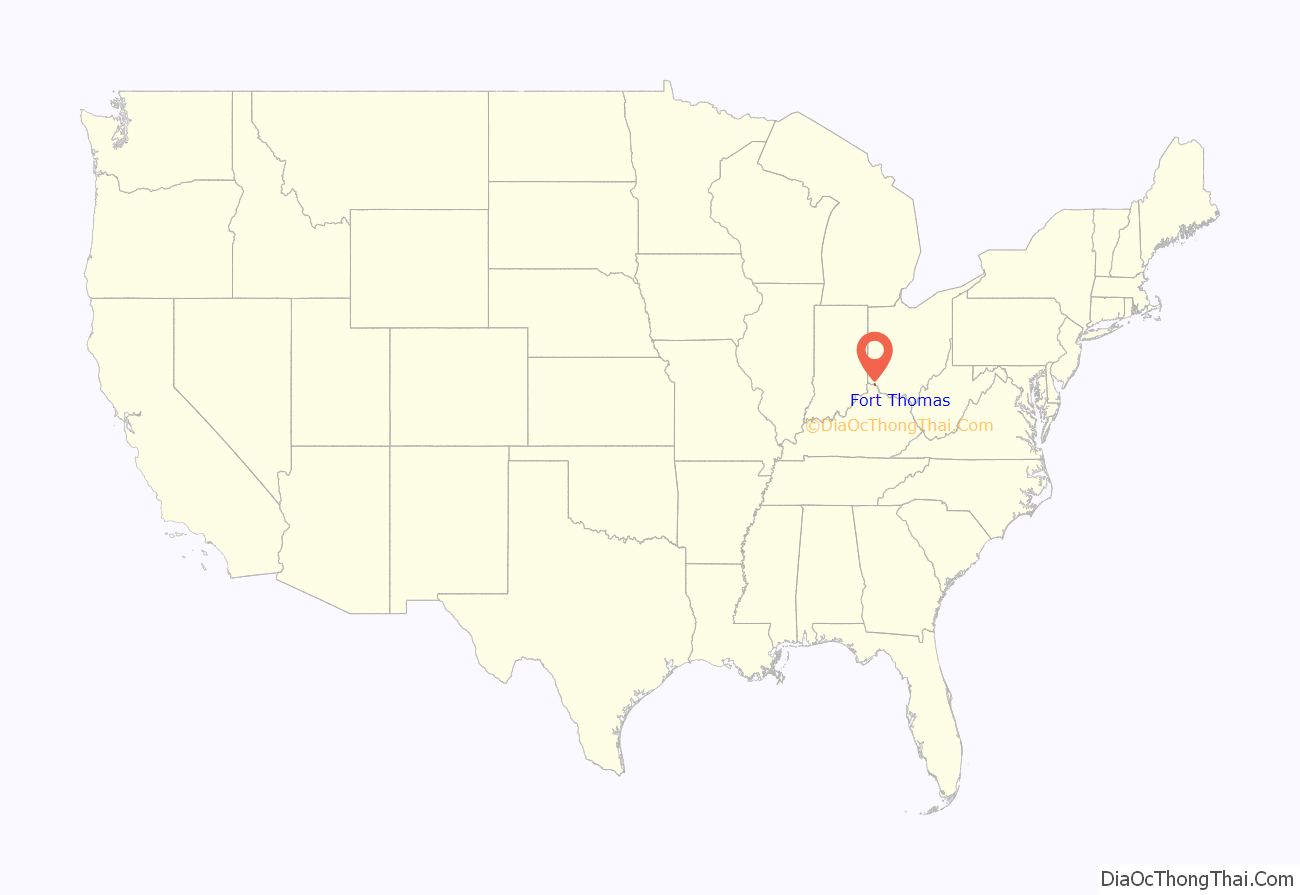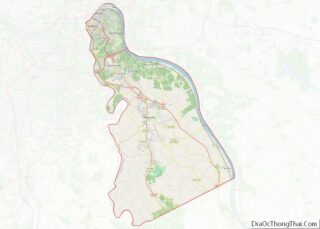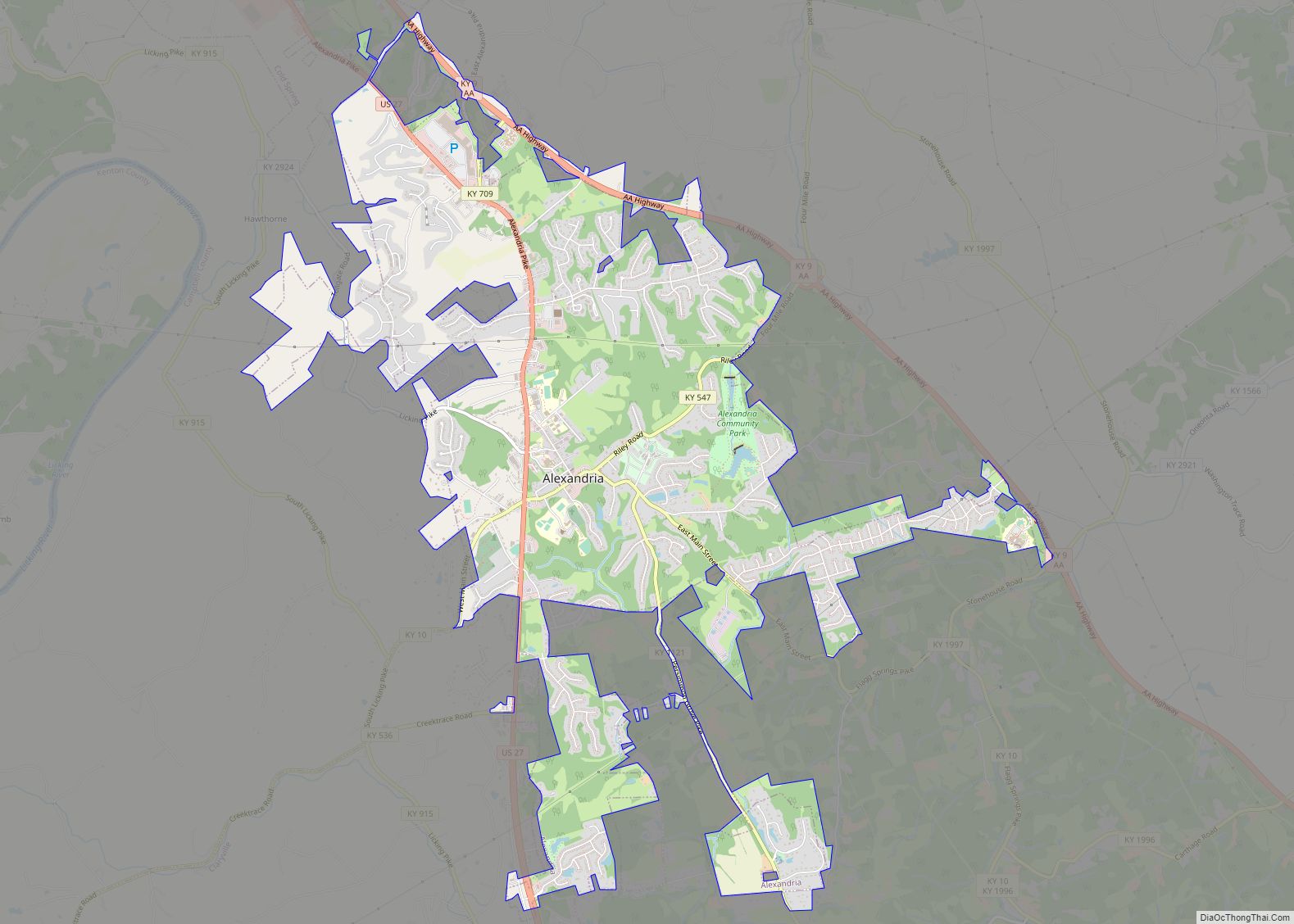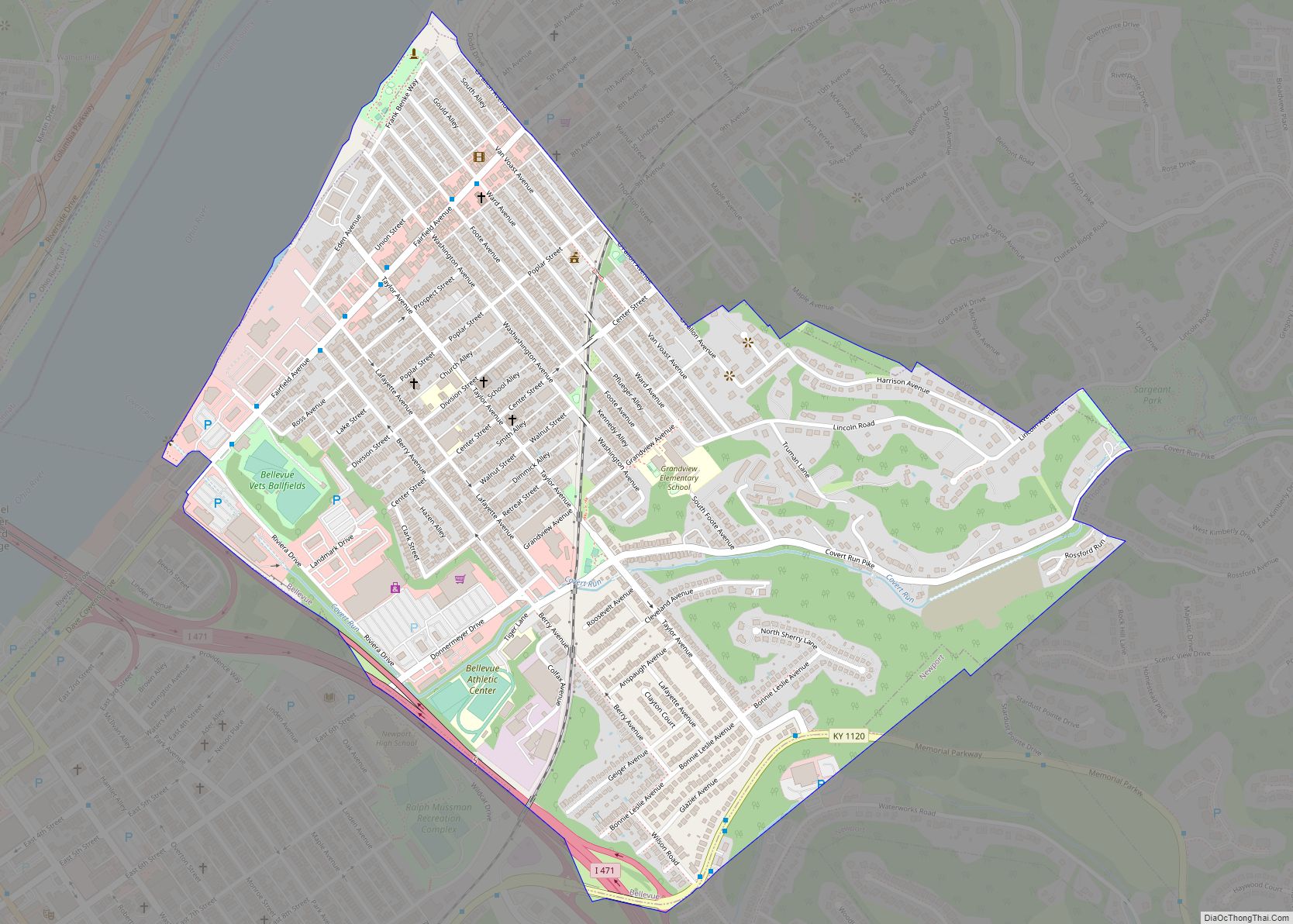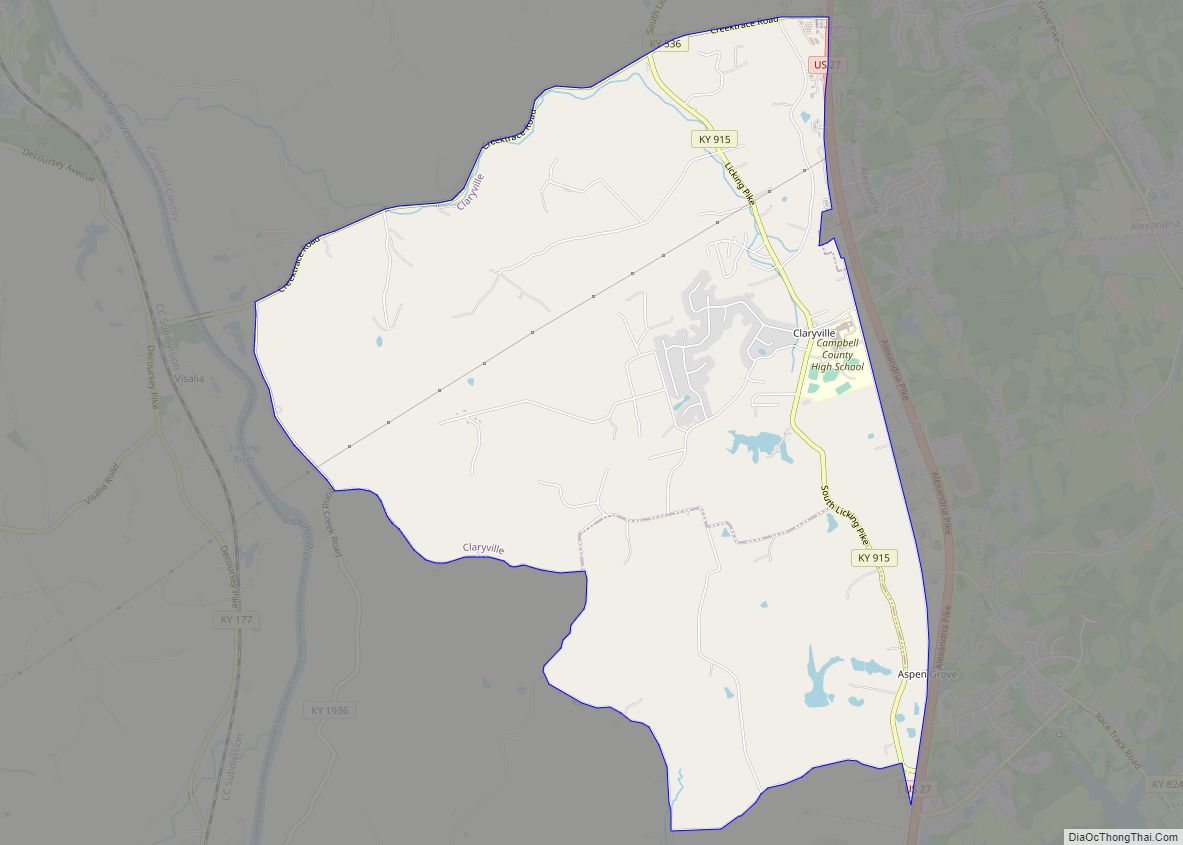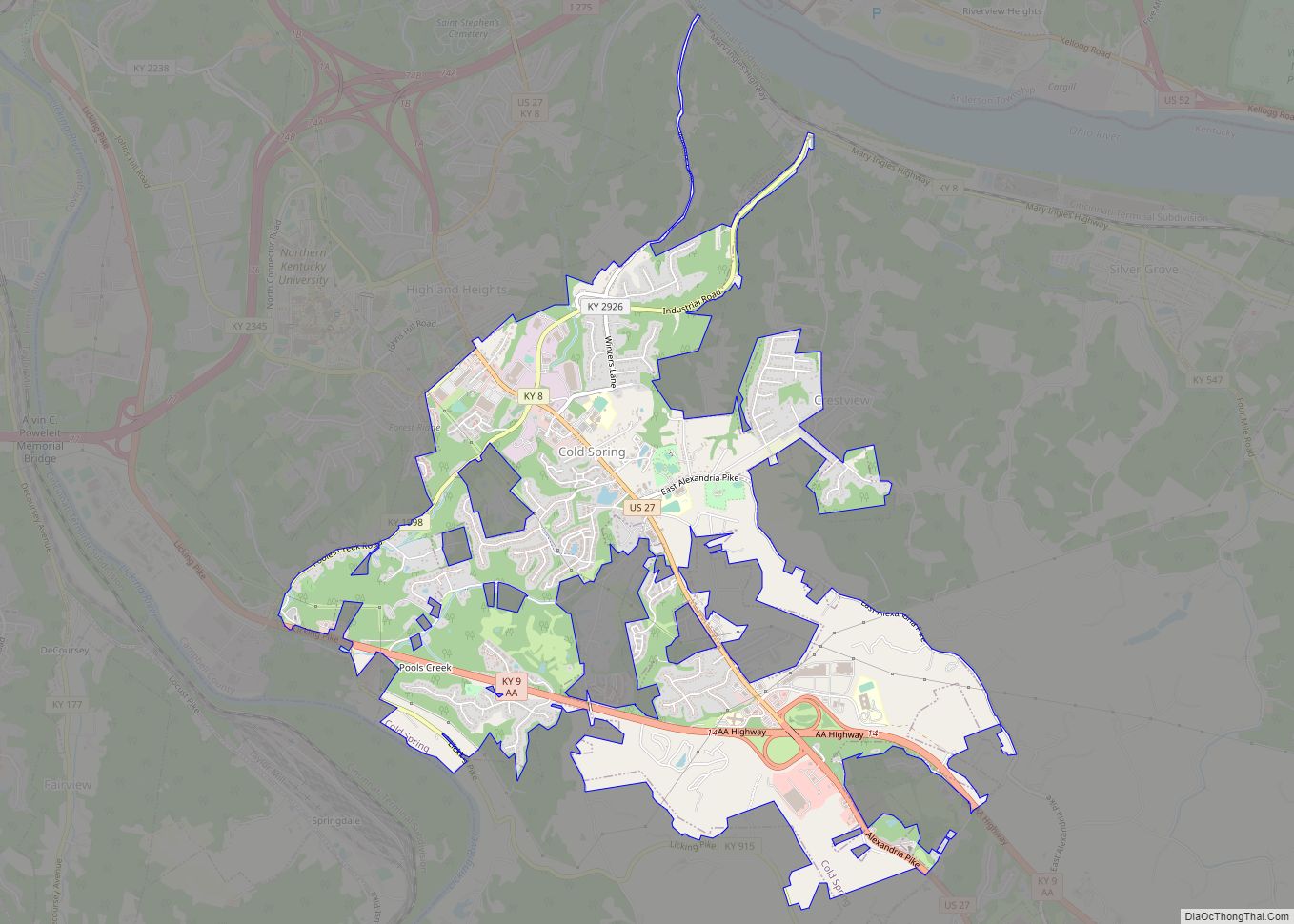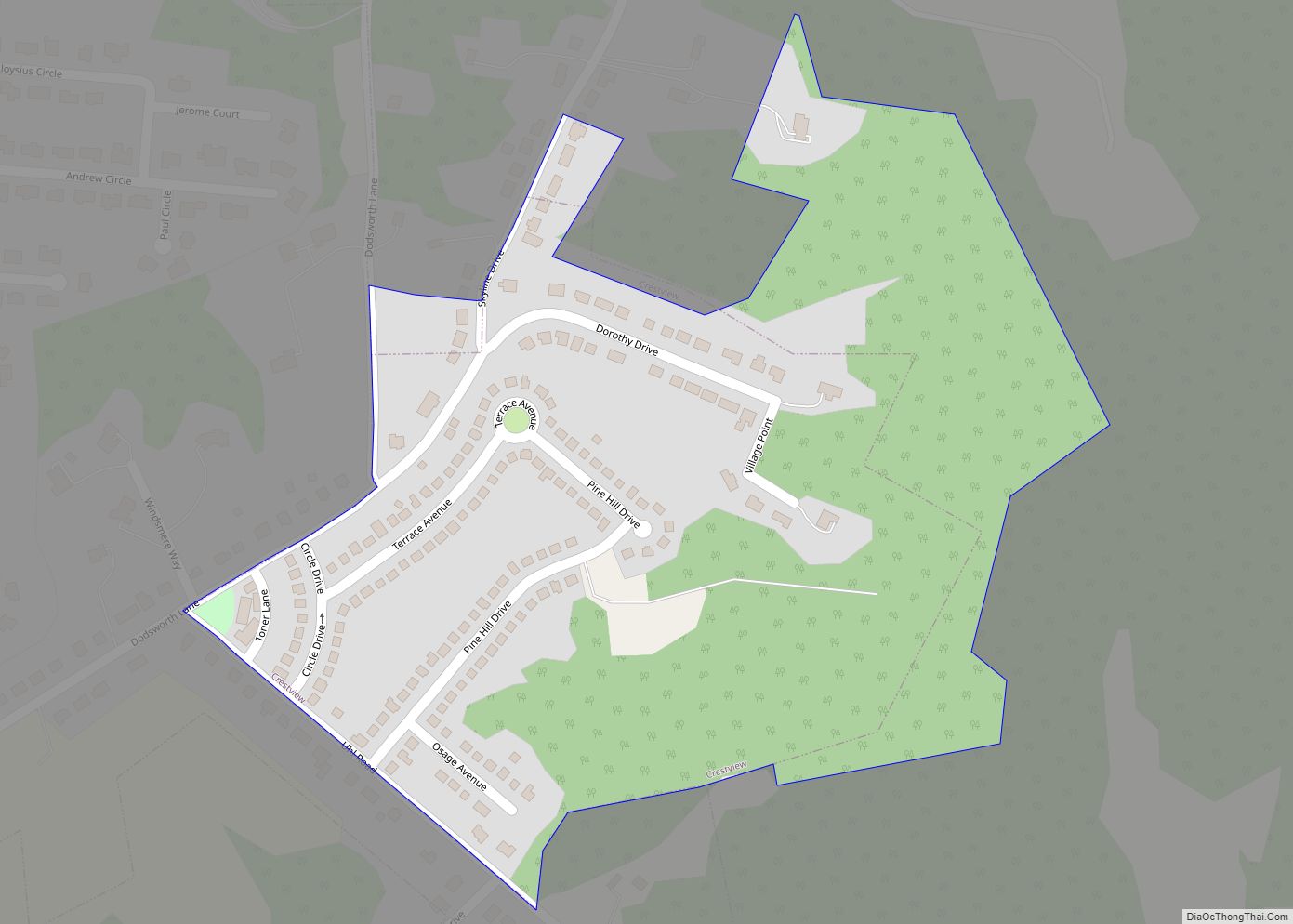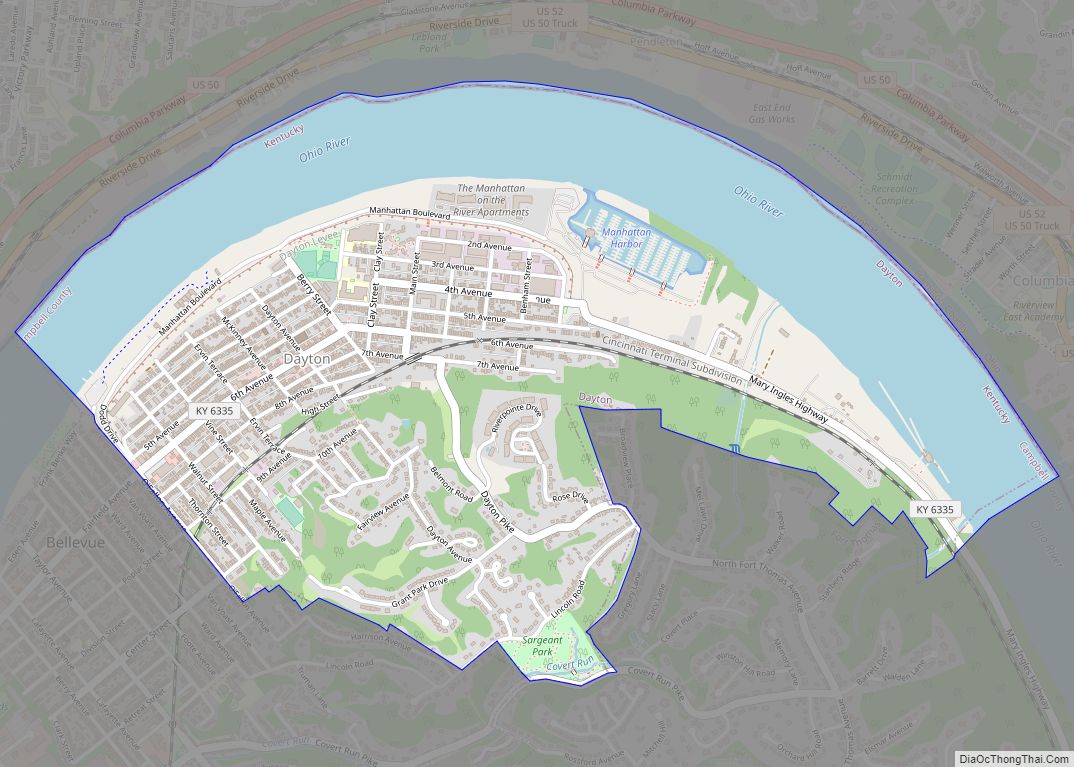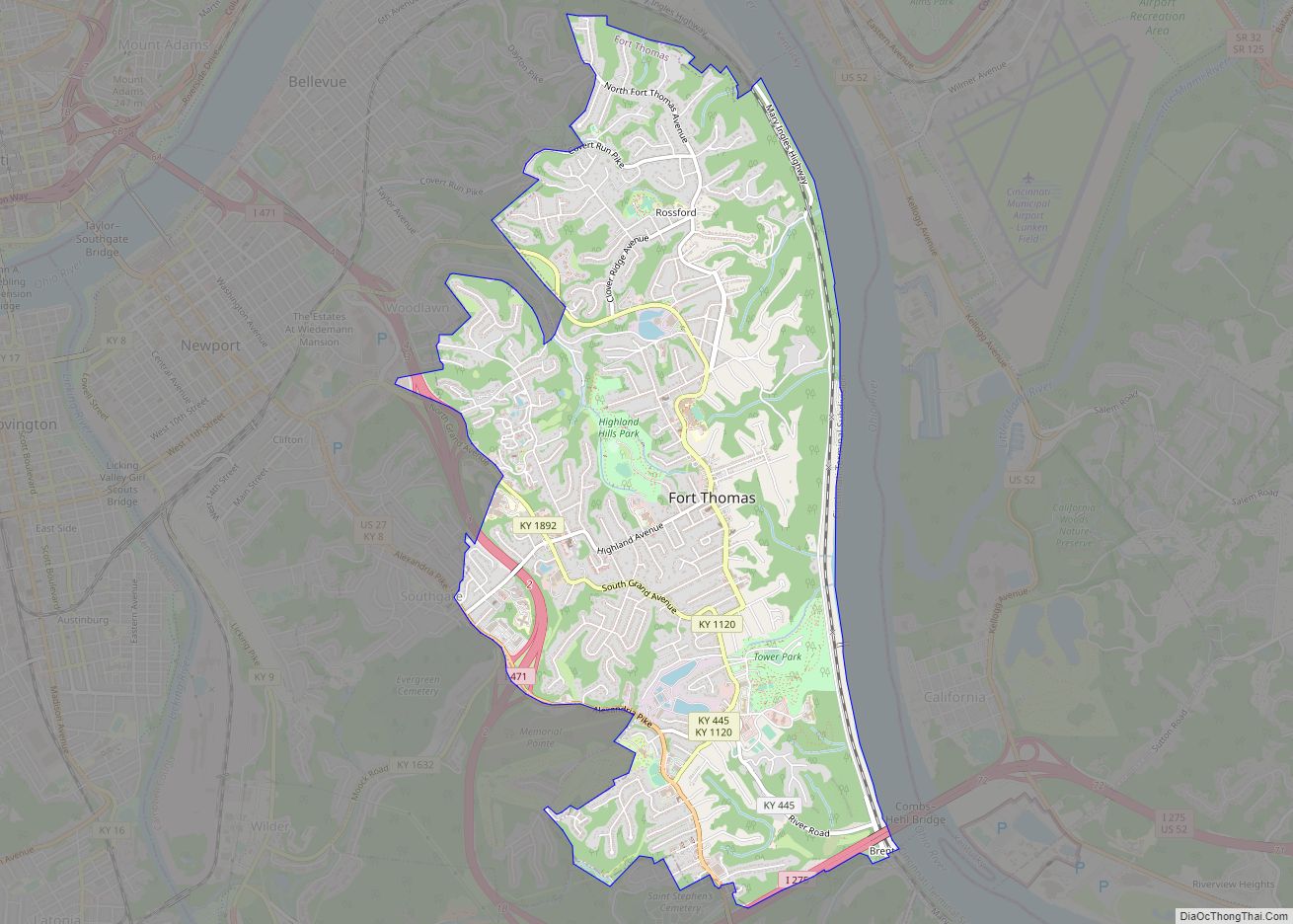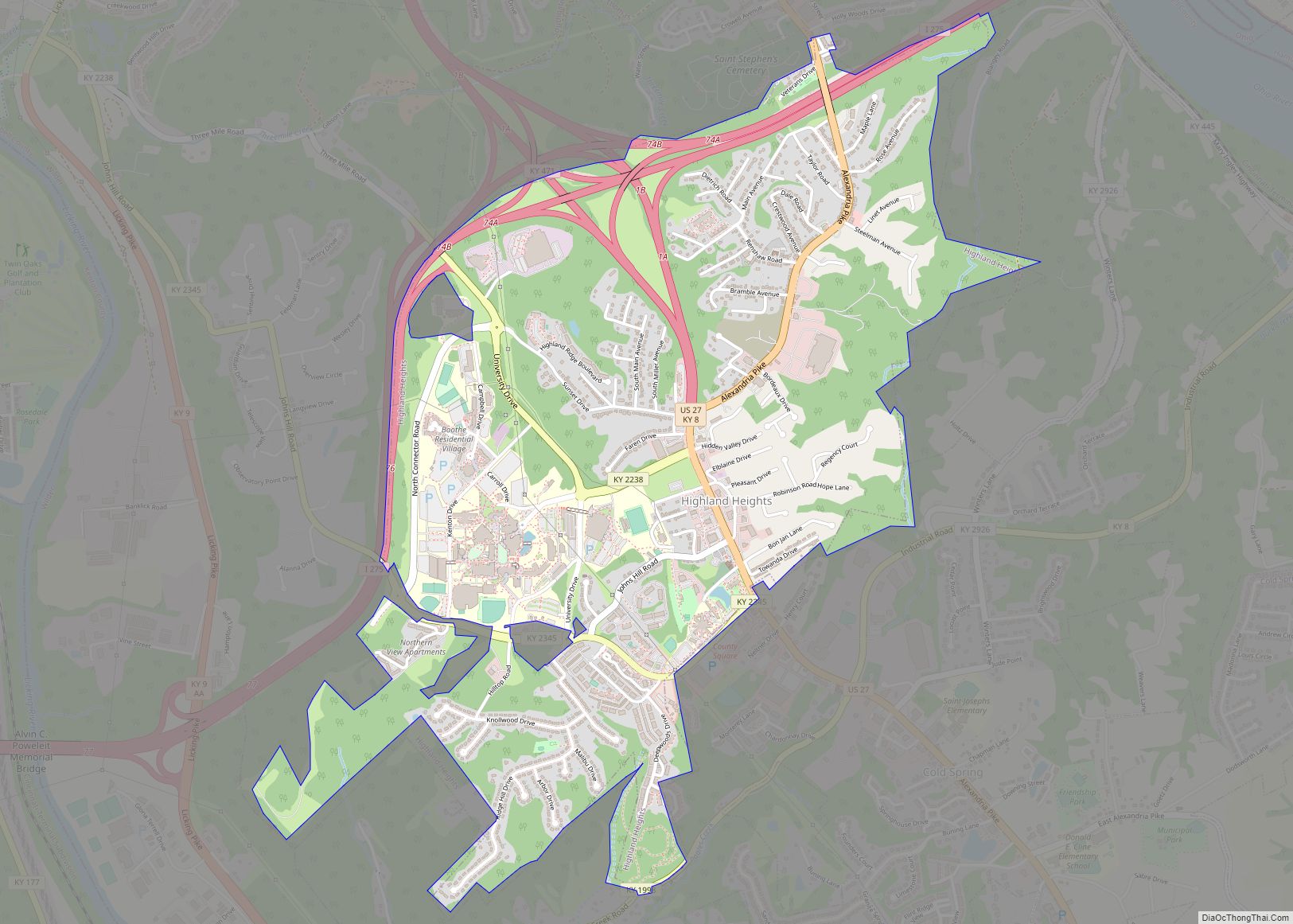Fort Thomas is a home rule-class city in Campbell County, Kentucky, United States, on the southern bank of the Ohio River and the site of an 1890 US Army post. The population was 16,325 at the 2010 census, making it the largest city in Campbell County and it is officially part of the Cincinnati – Northern Kentucky metropolitan area.
| Name: | Fort Thomas city |
|---|---|
| LSAD Code: | 25 |
| LSAD Description: | city (suffix) |
| State: | Kentucky |
| County: | Campbell County |
| Incorporated: | October 6, 1914 |
| Elevation: | 860 ft (262 m) |
| Total Area: | 5.69 sq mi (14.74 km²) |
| Land Area: | 5.67 sq mi (14.69 km²) |
| Water Area: | 0.02 sq mi (0.05 km²) |
| Total Population: | 17,438 |
| Population Density: | 3,073.32/sq mi (1,186.69/km²) |
| Area code: | 859 |
| FIPS code: | 2128594 |
| GNISfeature ID: | 0492357 |
| Website: | ftthomas.org |
Online Interactive Map
Click on ![]() to view map in "full screen" mode.
to view map in "full screen" mode.
Fort Thomas location map. Where is Fort Thomas city?
History
Evidence suggests that on or around 1749, prior to settlement by Europeans, a large battle occurred between a band of Cherokee Native Americans and victorious Miami tribe and Shawnee tribe Native Americans in what is now the city of Fort Thomas. As many as 600 graves of slain warriors have been unearthed by archeologists there; although the battleground area has been thoroughly combed for artifacts and remains over the years, it is still not uncommon to find arrowheads and other artifacts from the past while gardening or hiking the woods and streambeds throughout the city.
Fort Thomas Army Post
In 1887, a site was needed to house a United States Army post to replace Newport Barracks located in the adjoining city of Newport, Kentucky. Built in 1803, Newport Barracks replaced the smaller Fort Washington, located across the Ohio River in Cincinnati, Ohio. That army post was located at the junction of the Licking and Ohio Rivers, but it was prone to flooding and flooded numerous times during the early 1880s. A new, less flood prone location was sought. General Philip Sheridan personally selected 11 acres (4.5 ha) of the city and dubbed the area the Highlands, predicting it to become the “West Point of the West.” The new post was named Fort Thomas in honor of General George Henry Thomas.
The area has many remnants of this era with a 102-foot (31 m) high Stone Water Tower as a familiar landmark which stands at the entrance to Tower Park. It was the 16th structure built on the grounds of the Military Reservation. It encloses a standpipe which has a capacity of 100,000 gallons, pumped from the Water District reservoirs just across South Fort Thomas Avenue. In 1890 when the military base was established, such provisions for water supply was necessary as there was no other water tower in this area. Cannons that were captured in Cuba‘s Havana Harbor during the Spanish–American War rest on stone platforms in front of the Tower. The dates marked on these cannons, reflecting the date they were made in Barcelona, Spain, are “1768” and “1769.”
The U.S. 6th Infantry Regiment moved to Fort Thomas, where it remained until called to action again in June 1898, in the Spanish–American War.
Also stationed at Fort Thomas during the Spanish–American War were the 8th Volunteer Infantry, known as the “8th Immunes.” At the time, many erroneously believed that African Americans were naturally immune to tropical diseases or at least were better suited for service in the tropical environment of the Caribbean, and fearing the outbreak of tropical disease, actively recruited African-American soldiers for the conflict. Also, active service in the armed forces was considered beneficial to the status of African Americans in the United States, and was therefore lobbied for by civil rights leaders at the time. Booker T. Washington wrote the Secretary of the Navy that Cuba‘s climate was “peculiar and danger[o]us to the unaclimated [sic] white man. The Negro race in the South is accustomed to this climate.” Other black leaders lobbied in Washington to reserve all ten regiments for their race. Although they lacked the political clout to accomplish that lofty goal, President McKinley was well aware that most states had refused to accept black volunteers, and he wanted to recognize the martial spirit of the minority that staunchly supported his Republican party. On 26 May, the adjutant general’s office issued General Orders, No. 55, indicating that five of the Immune regiments would be composed of “persons of color,” commanded by officers who were also people of color. The others were composed of white men who had already contracted tropical diseases.
Samuel Woodfill was transferred to the Fort Thomas Army Post in 1912. He married Lorena Wiltshire on Christmas Day in 1917 and they purchased a house near the fort. In World War I he was courageous, leading his men against the Germans. His bravery earned him the Medal of Honor and other awards and he was described as the most decorated soldier of the war. In civilian life, however, he struggled to pay his bills. He was unsuccessful at creating an orchard, and worked as a carpenter, a watchman and a guard. His wife died in March 1942, but two months later, the Army commissioned Woodfill and another World War I hero, Alvin C. York as Majors to build morale and promote enlistments. Woodfill retired again in 1944, but memories of his wife in Fort Thomas caused him to return to Indiana, where he was born.
On February 25, 1937, Paul Tibbets enlisted here as a flying cadet in the United States Army Air Corps. During the last days of World War II, Paul became known as the pilot that dropped the first atomic bomb on August 6, 1945.
Fort Thomas served as a depot, induction center, and military hospital. Most of the garrison was transferred to the Veterans Administration in 1946, but military activities continued until the fort was closed in 1964.
Fort Thomas Road Map
Fort Thomas city Satellite Map
Geography
Fort Thomas is located at 39°4′34″N 84°27′5″W / 39.07611°N 84.45139°W / 39.07611; -84.45139 (39.076011, −84.451273). According to the United States Census Bureau, the city has a total area of 6.4 square miles (17 km), of which, 5.7 square miles (15 km) of it is land and 0.8 square miles (2.1 km) of it (11.82%) is water.
Climate
Fort Thomas is located within a climatic transition zone at the extreme northern limit of the humid subtropical climate. The local climate is a basically a blend of the subtropics to the south and the humid continental climate to the north. There are several “micro-climates” found in Fort Thomas which produce warmer than usual or cooler than usual “pockets”. In the warmer niches it is not at all uncommon to find such “subtropical” novelties as the common wall lizard, the Southern magnolia (Magnolia grandiflora), and even the rare Dwarf palmetto; Blue spruce and Salamander tend to occur in the cooler and shaded niches. Moderating variables for the overall climate of Fort Thomas include: the Ohio River, the region’s relatively large hills and valleys, and an urban heat influence due to the proximity of the Cincinnati/Northern Kentucky (Covington, Newport, etc.) metropolitan area. Fort Thomas is located within the Bluegrass region of Kentucky and Southern Ohio and is also situated within the northern periphery of the Upland South.
See also
Map of Kentucky State and its subdivision:- Adair
- Allen
- Anderson
- Ballard
- Barren
- Bath
- Bell
- Boone
- Bourbon
- Boyd
- Boyle
- Bracken
- Breathitt
- Breckinridge
- Bullitt
- Butler
- Caldwell
- Calloway
- Campbell
- Carlisle
- Carroll
- Carter
- Casey
- Christian
- Clark
- Clay
- Clinton
- Crittenden
- Cumberland
- Daviess
- Edmonson
- Elliott
- Estill
- Fayette
- Fleming
- Floyd
- Franklin
- Fulton
- Gallatin
- Garrard
- Grant
- Graves
- Grayson
- Green
- Greenup
- Hancock
- Hardin
- Harlan
- Harrison
- Hart
- Henderson
- Henry
- Hickman
- Hopkins
- Jackson
- Jefferson
- Jessamine
- Johnson
- Kenton
- Knott
- Knox
- Larue
- Laurel
- Lawrence
- Lee
- Leslie
- Letcher
- Lewis
- Lincoln
- Livingston
- Logan
- Lyon
- Madison
- Magoffin
- Marion
- Marshall
- Martin
- Mason
- McCracken
- McCreary
- McLean
- Meade
- Menifee
- Mercer
- Metcalfe
- Monroe
- Montgomery
- Morgan
- Muhlenberg
- Nelson
- Nicholas
- Ohio
- Oldham
- Owen
- Owsley
- Pendleton
- Perry
- Pike
- Powell
- Pulaski
- Robertson
- Rockcastle
- Rowan
- Russell
- Scott
- Shelby
- Simpson
- Spencer
- Taylor
- Todd
- Trigg
- Trimble
- Union
- Warren
- Washington
- Wayne
- Webster
- Whitley
- Wolfe
- Woodford
- Alabama
- Alaska
- Arizona
- Arkansas
- California
- Colorado
- Connecticut
- Delaware
- District of Columbia
- Florida
- Georgia
- Hawaii
- Idaho
- Illinois
- Indiana
- Iowa
- Kansas
- Kentucky
- Louisiana
- Maine
- Maryland
- Massachusetts
- Michigan
- Minnesota
- Mississippi
- Missouri
- Montana
- Nebraska
- Nevada
- New Hampshire
- New Jersey
- New Mexico
- New York
- North Carolina
- North Dakota
- Ohio
- Oklahoma
- Oregon
- Pennsylvania
- Rhode Island
- South Carolina
- South Dakota
- Tennessee
- Texas
- Utah
- Vermont
- Virginia
- Washington
- West Virginia
- Wisconsin
- Wyoming
